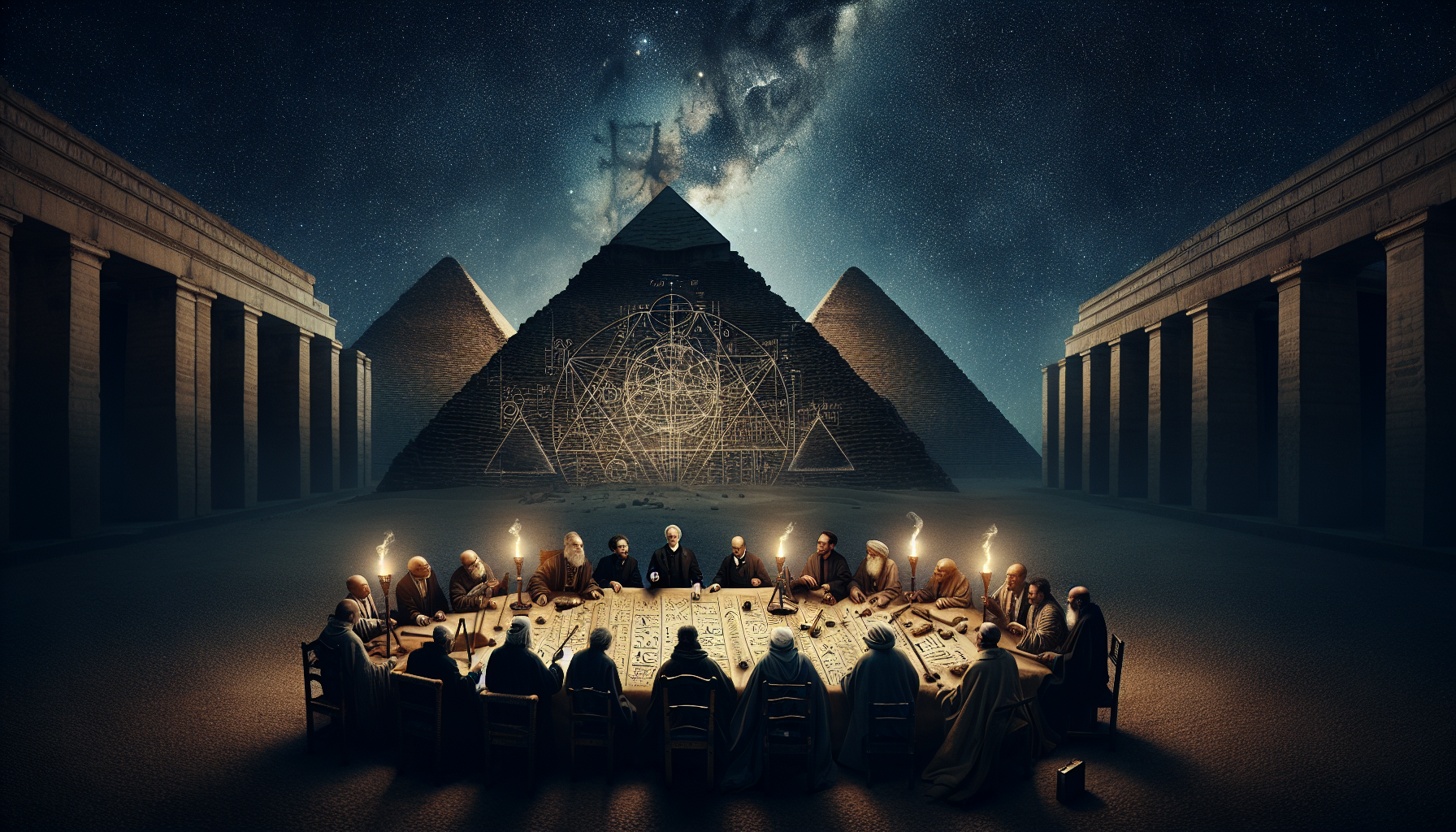In the heart of ancient Egypt, where the golden sands stretch endlessly under the unyielding sun, lies a testament to human ingenuity and divine inspiration that has captivated the world for millennia: the pyramids. These monumental structures, with their precise alignments and towering silhouettes, have been the subject of wonder, speculation, and study for countless generations. But what secrets do they hold? What ancient knowledge is encoded within their stone walls, and how can we, in the modern age, begin to unlock the mysteries of pyramidology—the study of these awe-inspiring edifices? 📜✨
Pyramidology is more than just an exploration of architectural feats; it is a journey into the ancient world’s mind, a glimpse into the philosophies and spiritual beliefs that shaped civilizations. In this blog, we will delve deep into the theories that surround the pyramids, from the divine proportions that hint at a cosmic connection, to the potential functions that range far beyond that of mere tombs. We’ll examine the mathematical precision that speaks to an advanced understanding of geometry and astronomy, and consider how these elements converge to suggest that the pyramids were built with an intentional purpose that transcends the earthly realm.
Join us as we unravel the threads of history and myth, science and spirituality. We’ll explore the various interpretations that scholars and enthusiasts have proposed over the years, each adding a layer of intrigue to the enigma of the pyramids. From the Great Pyramid of Giza to lesser-known structures that dot the landscape, we’ll analyze their construction, symbolism, and the enduring legacy they leave behind. Prepare to embark on a voyage of discovery that seeks not only to understand these ancient wonders but also to appreciate the profound impact they have had on human culture and consciousness throughout the ages. 🌍🔍
Understanding Pyramidology: The Intersection of History and Mysticism
Pyramidology is a fascinating field that sits at the intersection of archaeology, history, and mysticism. Rooted in the study of pyramids, primarily those of ancient Egypt, pyramidology seeks to uncover the hidden knowledge and divine proportions embedded in these ancient structures. The Great Pyramid of Giza, the most famous of these monuments, has been the subject of countless theories and speculations over the centuries. From its mathematical precision to its supposed mystical powers, the Great Pyramid has intrigued scholars, mystics, and tourists alike.
One of the most compelling aspects of pyramidology is the belief that the pyramids are more than just tombs for pharaohs. Some researchers suggest they were constructed with advanced knowledge of mathematics and astronomy. The Great Pyramid, for instance, is aligned with incredible precision to the cardinal points of the compass. This alignment, combined with its dimensions, has led some to speculate that the pyramids were built to serve as astronomical observatories or even as repositories of ancient knowledge. Theories about the pyramids’ purpose continue to evolve, influenced by new discoveries and technological advancements in archaeology.
The mysteries of pyramidology extend beyond the structural and into the metaphysical. Many believe that pyramids possess healing powers and can enhance spiritual energy. This belief is rooted in the idea that the shape of the pyramid can focus and amplify energy, a concept that has been adopted by practitioners of alternative medicine and spiritual practices. Whether or not these claims hold scientific merit, the notion of pyramids as mystical structures continues to capture the human imagination.
The Mathematical Mysteries of the Great Pyramid
The mathematical precision of the Great Pyramid has been a source of fascination for centuries. Its dimensions are not only impressive but also reflect a deep understanding of mathematical principles that seem advanced for the time. The base of the Great Pyramid is a nearly perfect square, with sides that are approximately 230 meters long. What is truly remarkable, however, is the ratio of the pyramid’s base perimeter to its height, which is nearly equal to 2π (pi), a mathematical constant that is crucial in the study of circles and spheres.
This seemingly deliberate inclusion of π in the pyramid’s design has led many to speculate that the ancient Egyptians possessed a sophisticated understanding of mathematics. Some pyramidologists argue that this knowledge was not indigenous but perhaps inherited from a lost civilization or even extraterrestrial visitors. While mainstream archaeology attributes the precision of the pyramids to the Egyptians’ advanced surveying skills, the debate continues about the extent of their mathematical knowledge.
Additionally, the Great Pyramid’s proportions may also reflect the golden ratio, φ (phi), another mathematical constant often associated with aesthetic beauty and harmony. The relationship between the height of the pyramid and the width of its base is said to approximate the golden ratio, leading some to propose that the pyramid was constructed to embody this divine proportion. This belief aligns with the notion that the pyramids were not merely utilitarian structures but were designed to represent deeper philosophical and cosmological truths.
Exploring the Mystical Powers of Pyramids
The mystical aspects of pyramidology offer a rich area for exploration, blending ancient beliefs with modern-day spiritual practices. Many adherents of pyramidology claim that pyramids possess unique energies that can be harnessed for various purposes, from healing to meditation. The shape of the pyramid is thought to channel cosmic energy, which can be beneficial for both physical and mental well-being.
One of the most popular applications of pyramid power is in meditation and relaxation practices. It is believed that meditating under a pyramid structure can enhance concentration, promote a sense of peace, and even facilitate spiritual enlightenment. This practice has gained traction among those who are interested in alternative spirituality and holistic health. While scientific validation of these claims is lacking, the subjective experiences of practitioners keep the belief in pyramid power alive.
The supposed healing properties of pyramids have also been embraced by some in the alternative health community. Pyramid-shaped structures are used to enhance the energy of crystals, purify water, and even preserve food. These practices are based on the belief that the pyramid shape can concentrate and amplify natural energies. Again, while empirical evidence is limited, the enduring popularity of these practices suggests that many find personal value in them.
Scientific Perspectives and Skepticism
While pyramidology is rich with intriguing theories, it also attracts skepticism from the scientific community. Mainstream archaeologists and historians typically attribute the construction of the pyramids to the ingenuity and resourcefulness of the ancient Egyptians, without invoking lost civilizations or mystical powers. They argue that the alignment and dimensions of the pyramids can be explained by the Egyptians’ advanced knowledge of surveying and their ability to organize large labor forces.
The debate over the pyramids’ purpose and construction methods remains a topic of intense discussion. Some researchers point to the lack of direct evidence supporting the more speculative claims of pyramidology. For instance, while the mathematical constants of π and φ are intriguing, there is no conclusive evidence that the ancient Egyptians intentionally incorporated these values into their designs. Similarly, claims about the pyramids’ mystical powers are often dismissed as pseudoscience due to a lack of empirical support.
Table: Comparison of Theories on the Purpose of Pyramids
| Theory | Description | Supporting Evidence |
|---|---|---|
| Tombs for Pharaohs | Pyramids were constructed as elaborate tombs for pharaohs and their consorts. | Discovery of sarcophagi and burial artifacts in pyramids. |
| Astronomical Observatories | Pyramids were used to study celestial phenomena and align with stars. | Precise alignment with cardinal points and significant stars. |
| Energy Amplifiers | Pyramids were built to harness and amplify cosmic energies for various purposes. | Anecdotal evidence of enhanced meditation and healing experiences. |
Explore these fascinating theories further by watching this insightful video: The Mystery of the Pyramids – Ancient Wisdom (Channel Name) 📺
The Legacy of Pyramidology
- Dive deeper into pyramidology by reading classic texts and recent studies.
- Join online communities to discuss theories and share discoveries with fellow enthusiasts.
- Consider visiting the pyramids in Egypt to experience their majesty firsthand.

Conclusion
Conclusion: Unveiling the Mysteries of Pyramidology: Unlocking the Secrets of Divine Proportions
As we draw this exploration of pyramidology to a close, it becomes abundantly clear that the fascination with pyramids is not just an infatuation with ancient structures, but a profound inquiry into the secrets of divine proportions and human ingenuity. Throughout this article, we have journeyed through the sands of time, delving into the depths of both historical and modern interpretations of pyramids. These architectural marvels, with their precise alignments and geometrical sophistication, continue to captivate the imagination of scholars, historians, and enthusiasts alike.
To recap, we began by examining the historical context of pyramids, primarily focusing on the ancient Egyptian pyramids, which are perhaps the most iconic. We discussed how these structures were not merely tombs, but also served as a testament to the ancient Egyptians’ advanced understanding of mathematics and astronomy. The Great Pyramid of Giza, in particular, exemplifies the pinnacle of pyramid construction, with its precise alignment to the cardinal points and the Golden Ratio, which continues to intrigue researchers today.
Moving beyond the historical aspects, we explored the mystical and symbolic interpretations of pyramidology. This involves the belief that pyramids are imbued with mystical energies and that their shape can influence the metaphysical realm. This perspective suggests that the pyramids serve as conduits of cosmic energy, potentially impacting everything from human consciousness to the Earth’s magnetic field. While scientific evidence to support these claims remains elusive, the allure of such possibilities fuels ongoing interest and research.
Our exploration also took us into the realm of modern pyramidology, where contemporary researchers employ advanced technology and new methodologies to unlock the secrets held within these ancient structures. From satellite imaging to 3D modeling, modern science is gradually peeling back the layers of mystery, revealing insights into the construction techniques and cultural significance of the pyramids.
The article further discussed the intersection of pyramidology with various disciplines such as mathematics, art, and spirituality. The pyramids’ alignment with celestial bodies, their embodiment of the Golden Ratio, and their influence on architectural designs across cultures underscore their universal significance. This multidisciplinary approach enriches our understanding and appreciation of pyramids, prompting us to consider them not just as historical relics, but as eternal symbols of human aspiration and achievement.
In reinforcing the importance of this theme, it is crucial to recognize that the study of pyramids is more than an academic exercise; it is a journey into understanding humanity itself. The pyramids stand as a testament to human creativity, ambition, and the timeless quest for knowledge. They remind us of our connection to the past and inspire us to look forward to future discoveries that await.
We invite you, dear reader, to delve deeper into the fascinating world of pyramidology. Whether you are a seasoned scholar or a curious enthusiast, there is always more to learn and explore. Share this article with friends and colleagues who might be interested in the mysteries of the pyramids. Engage in discussions, whether online or in person, to expand your perspective and exchange ideas. 🌟
For further exploration, you can access additional resources and research papers from reputable sources such as Smithsonian Magazine and National Geographic, which continue to provide valuable insights into the world of ancient civilizations and pyramid studies.
In conclusion, the pyramids stand as enduring symbols of human achievement, beckoning us to unlock their secrets and learn from their timeless wisdom. Let us embrace the spirit of discovery and continue to explore these architectural wonders, for in understanding them, we gain a deeper understanding of ourselves and the world we inhabit. Let this journey into the mysteries of pyramidology inspire you to seek out knowledge, to question, and to marvel at the wonders of human ingenuity. 🏺
Thank you for joining us on this exploration. We look forward to hearing your thoughts and reflections. Please leave a comment below and let’s continue this fascinating conversation!
Toni Santos is a visual storyteller and conceptual archivist whose work explores the curious, often poetic ruins of pseudoscience and obsolete theories. With a reverence for forgotten frameworks and fantastical logic, Toni illuminates the imaginative spaces where science once drifted into myth, speculation, and symbolic belief.
His creative path is rooted in a fascination with the fringe — from phrenology maps to ether diagrams, hollow earth charts to animal magnetism illustrations. Each visual Toni creates or curates is an invitation to reexamine the strange beauty of discarded knowledge — not as failure, but as cultural reflection, as art born from our eternal desire to explain the unexplainable.
Blending visual design with historical inquiry, Toni gives new life to lost diagrams, metaphysical charts, and antique engravings that once shaped worldviews. His work occupies the liminal zone between fact and fiction, where obsolete models still pulse with philosophical resonance and forgotten charm.
As the mind behind Vizovex, Toni shares illustrated essays, curated collections, and visual reinterpretations that invite others to explore the aesthetic and symbolic value of outdated theories. His goal is not to validate, but to remember — to view these speculative systems as relics of human creativity, vulnerability, and yearning.
His work is a tribute to:
The elegance of error in the evolution of knowledge
The symbolic artistry of discarded explanations
The blurred lines between belief, observation, and imagination
Whether you’re a collector of curious ideas, a lover of forgotten diagrams, or someone drawn to the strange scaffolding of old worldviews, Toni opens a portal to a time when the universe was still full of ghosts, humors, and cosmic fluids — one chart, one symbol, one discredited wonder at a time.





